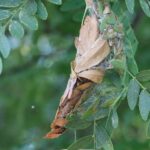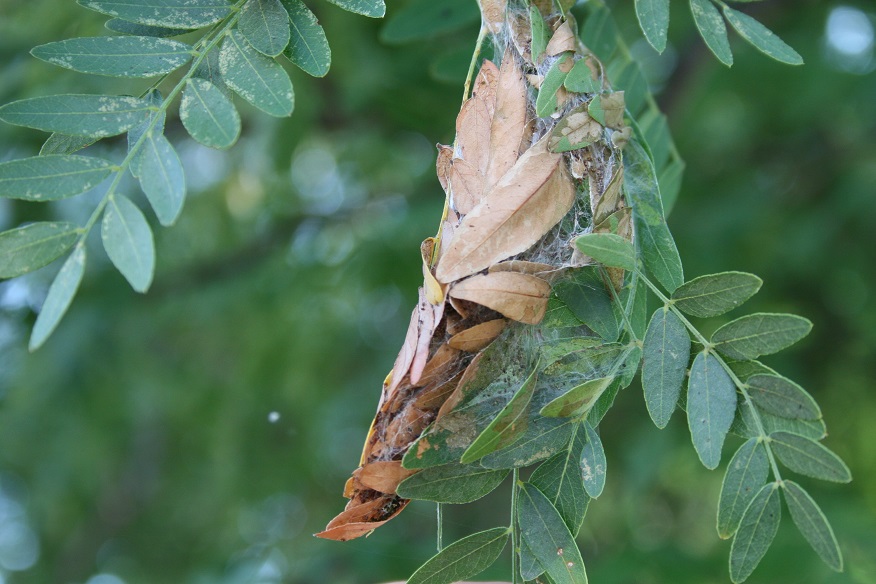
This Halloween, you might be heading to a haunted house to get your fix of ghouls, goblins and witches. But but you may only have to go as far as your own backyard to witness the horrors of imminent death. The death of your tree, that is!
Here are 5 symptoms that your tree may be haunted, and if it is, “Who you gonna call?” Arbor Aesthetics!
Oh, and that photo of the bloody tree? Don’t be scared, that’s just a Dragon Blood Tree!
Here are 5 symptoms that your tree may be haunted, and if it is, “Who you gonna call?” Arbor Aesthetics!
Oh, and that photo of the bloody tree? Don’t be scared, that’s just a Dragon Blood Tree!
1) Strangling
A stem girdling root could be strangling your tree and preventing the flow of nutrients through the trunk! These are often the result of improper planting or poor growing practices in the nursery. Ideally, these roots should be removed when the tree is planted, but you can also remove or sever the root later in its life to stop its growth. Planting a tree too deeply and soil compaction can also cause roots to grow in this manner. Click here for more information on removing girdling roots.
A stem girdling root could be strangling your tree and preventing the flow of nutrients through the trunk! These are often the result of improper planting or poor growing practices in the nursery. Ideally, these roots should be removed when the tree is planted, but you can also remove or sever the root later in its life to stop its growth. Planting a tree too deeply and soil compaction can also cause roots to grow in this manner. Click here for more information on removing girdling roots.

2) Oozing
Slime flux, or bacterial wetwood, presents itself as dark streaks of liquid running down a tree, usually originating from a wound or a crack. It’s the result of stress from things like soil compaction or internal damage. The slime is a defense mechanism and does no harm to the tree, however the slime may kill any grass or plants growing at the base of the tree.
You don’t need to treat slime flux, but it’s a symptom that shouldn’t be ignored and it’s an opportunity to address the cause of this condition so your tree won’t be DOOOOOOOMED!
Slime flux, or bacterial wetwood, presents itself as dark streaks of liquid running down a tree, usually originating from a wound or a crack. It’s the result of stress from things like soil compaction or internal damage. The slime is a defense mechanism and does no harm to the tree, however the slime may kill any grass or plants growing at the base of the tree.
You don’t need to treat slime flux, but it’s a symptom that shouldn’t be ignored and it’s an opportunity to address the cause of this condition so your tree won’t be DOOOOOOOMED!

3) Strange Growths
Fruiting bodies like the one pictured to the right are a sign of extensive internal decay. Fungi enter trees through bark wounds and dead branch stubs, then decay the heartwood and sapwood – the living wood of the tree that transfers nutrients up and down the trunk. You may often see them growing at the sight of where a branch was once removed improperly, which is why proper pruning is important. Remember to leave the branch collar intact when pruning limbs. More on that here.
If you see fruiting bodies, it’s time to call an arborist to inspect the structural integrity of your tree.
Fruiting bodies like the one pictured to the right are a sign of extensive internal decay. Fungi enter trees through bark wounds and dead branch stubs, then decay the heartwood and sapwood – the living wood of the tree that transfers nutrients up and down the trunk. You may often see them growing at the sight of where a branch was once removed improperly, which is why proper pruning is important. Remember to leave the branch collar intact when pruning limbs. More on that here.
If you see fruiting bodies, it’s time to call an arborist to inspect the structural integrity of your tree.

4) Gaping Wounds
Cracks and bark wounds are in invitation for bacterial and fungal infection. Bark is like skin – be gentle and treat it with care. Keep weed whackers away from the trunk. Do not drill holes into your tree for any reason. Make proper pruning cuts using sharp tools and educate yourself on how to make proper cuts so that the tree can seal over its wounds and prevent decay.
If you see a crack at a branch union like the one pictured or a crack in the trunk, steer clear of the area and call an arborist immediately!
Cracks and bark wounds are in invitation for bacterial and fungal infection. Bark is like skin – be gentle and treat it with care. Keep weed whackers away from the trunk. Do not drill holes into your tree for any reason. Make proper pruning cuts using sharp tools and educate yourself on how to make proper cuts so that the tree can seal over its wounds and prevent decay.
If you see a crack at a branch union like the one pictured or a crack in the trunk, steer clear of the area and call an arborist immediately!

5) Dead Limbs
Dying branches here and there are a normal part of a tree’s life. However, if you start to notice excessive die-back of limbs, or notice that the tree is prematurely losing leaves from the outside in, it may be a sign of root system problems, insect infestation, or disease. The tree is unable to effectively feed its canopy and it’s time to look at and address factors that could be causing this.
Dying branches here and there are a normal part of a tree’s life. However, if you start to notice excessive die-back of limbs, or notice that the tree is prematurely losing leaves from the outside in, it may be a sign of root system problems, insect infestation, or disease. The tree is unable to effectively feed its canopy and it’s time to look at and address factors that could be causing this.

Conclusion…
Okay, so your tree probably isn’t “doomed,” but it’s important to know and be aware of symptoms of distress, like those listed above, so that you can take action to slow or prevent the death of your tree. Trees generally die a slow death, and more often than not, due to a number of factors. If in doubt, consult with an arborist for peace of mind!
Sources:
– https://extension.umd.edu/hgic/girdling-roots-trees-and-shrubs
– http://extension.psu.edu/pests/plant-diseases/all-fact-sheets/wetwood-or-slime-flux
– http://ipm.ucanr.edu/PMG/PESTNOTES/pn74109.html
– https://extension.umd.edu/hgic/girdling-roots-trees-and-shrubs
– http://extension.psu.edu/pests/plant-diseases/all-fact-sheets/wetwood-or-slime-flux
– http://ipm.ucanr.edu/PMG/PESTNOTES/pn74109.html






